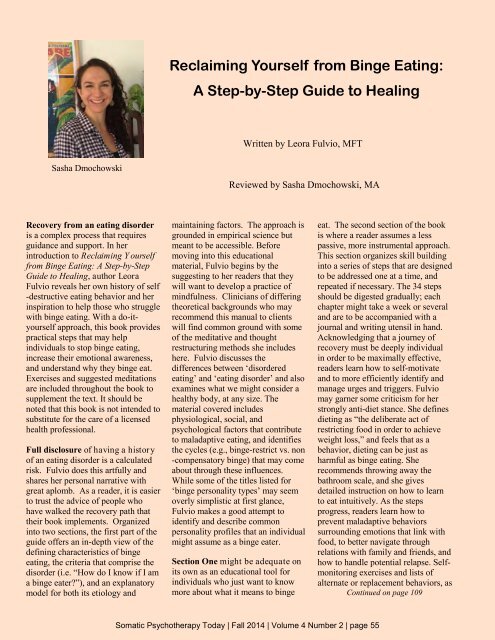SPT-Fall2014
SPT-Fall2014
SPT-Fall2014
Create successful ePaper yourself
Turn your PDF publications into a flip-book with our unique Google optimized e-Paper software.
Reclaiming Yourself from Binge Eating:<br />
A Step-by-Step Guide to Healing<br />
Written by Leora Fulvio, MFT<br />
Sasha Dmochowski<br />
Reviewed by Sasha Dmochowski, MA<br />
Recovery from an eating disorder<br />
is a complex process that requires<br />
guidance and support. In her<br />
introduction to Reclaiming Y ourself<br />
from Binge Eating: A Step-by-Step<br />
Guide to Healing, author Leora<br />
Fulvio reveals her own history of self<br />
-destructive eating behavior and her<br />
inspiration to help those who struggle<br />
with binge eating. With a do-ityourself<br />
approach, this book provides<br />
practical steps that may help<br />
individuals to stop binge eating,<br />
increase their emotional awareness,<br />
and understand why they binge eat.<br />
Exercises and suggested meditations<br />
are included throughout the book to<br />
supplement the text. It should be<br />
noted that this book is not intended to<br />
substitute for the care of a licensed<br />
health professional.<br />
Full disclosure of having a history<br />
of an eating disorder is a calculated<br />
risk. Fulvio does this artfully and<br />
shares her personal narrative with<br />
great aplomb. As a reader, it is easier<br />
to trust the advice of people who<br />
have walked the recovery path that<br />
their book implements. Organized<br />
into two sections, the first part of the<br />
guide offers an in-depth view of the<br />
defining characteristics of binge<br />
eating, the criteria that comprise the<br />
disorder (i.e. “How do I know if I am<br />
a binge eater?”), and an explanatory<br />
model for both its etiology and<br />
maintaining factors. The approach is<br />
grounded in empirical science but<br />
meant to be accessible. Before<br />
moving into this educational<br />
material, Fulvio begins by the<br />
suggesting to her readers that they<br />
will want to develop a practice of<br />
mindfulness. Clinicians of differing<br />
theoretical backgrounds who may<br />
recommend this manual to clients<br />
will find common ground with some<br />
of the meditative and thought<br />
restructuring methods she includes<br />
here. Fulvio discusses the<br />
differences between ‘disordered<br />
eating’ and ‘eating disorder’ and also<br />
examines what we might consider a<br />
healthy body, at any size. The<br />
material covered includes<br />
physiological, social, and<br />
psychological factors that contribute<br />
to maladaptive eating, and identifies<br />
the cycles (e.g., binge-restrict vs. non<br />
-compensatory binge) that may come<br />
about through these influences.<br />
While some of the titles listed for<br />
‘binge personality types’ may seem<br />
overly simplistic at first glance,<br />
Fulvio makes a good attempt to<br />
identify and describe common<br />
personality profiles that an individual<br />
might assume as a binge eater.<br />
Section One might be adequate on<br />
its own as an educational tool for<br />
individuals who just want to know<br />
more about what it means to binge<br />
eat. The second section of the book<br />
is where a reader assumes a less<br />
passive, more instrumental approach.<br />
This section organizes skill building<br />
into a series of steps that are designed<br />
to be addressed one at a time, and<br />
repeated if necessary. The 34 steps<br />
should be digested gradually; each<br />
chapter might take a week or several<br />
and are to be accompanied with a<br />
journal and writing utensil in hand.<br />
Acknowledging that a journey of<br />
recovery must be deeply individual<br />
in order to be maximally effective,<br />
readers learn how to self-motivate<br />
and to more efficiently identify and<br />
manage urges and triggers. Fulvio<br />
may garner some criticism for her<br />
strongly anti-diet stance. She defines<br />
dieting as “the deliberate act of<br />
restricting food in order to achieve<br />
weight loss,” and feels that as a<br />
behavior, dieting can be just as<br />
harmful as binge eating. She<br />
recommends throwing away the<br />
bathroom scale, and she gives<br />
detailed instruction on how to learn<br />
to eat intuitively. As the steps<br />
progress, readers learn how to<br />
prevent maladaptive behaviors<br />
surrounding emotions that link with<br />
food, to better navigate through<br />
relations with family and friends, and<br />
how to handle potential relapse. Selfmonitoring<br />
exercises and lists of<br />
alternate or replacement behaviors, as<br />
Continued on page 109<br />
Somatic Psychotherapy Today | Fall 2014 | Volume 4 Number 2 | page 55


